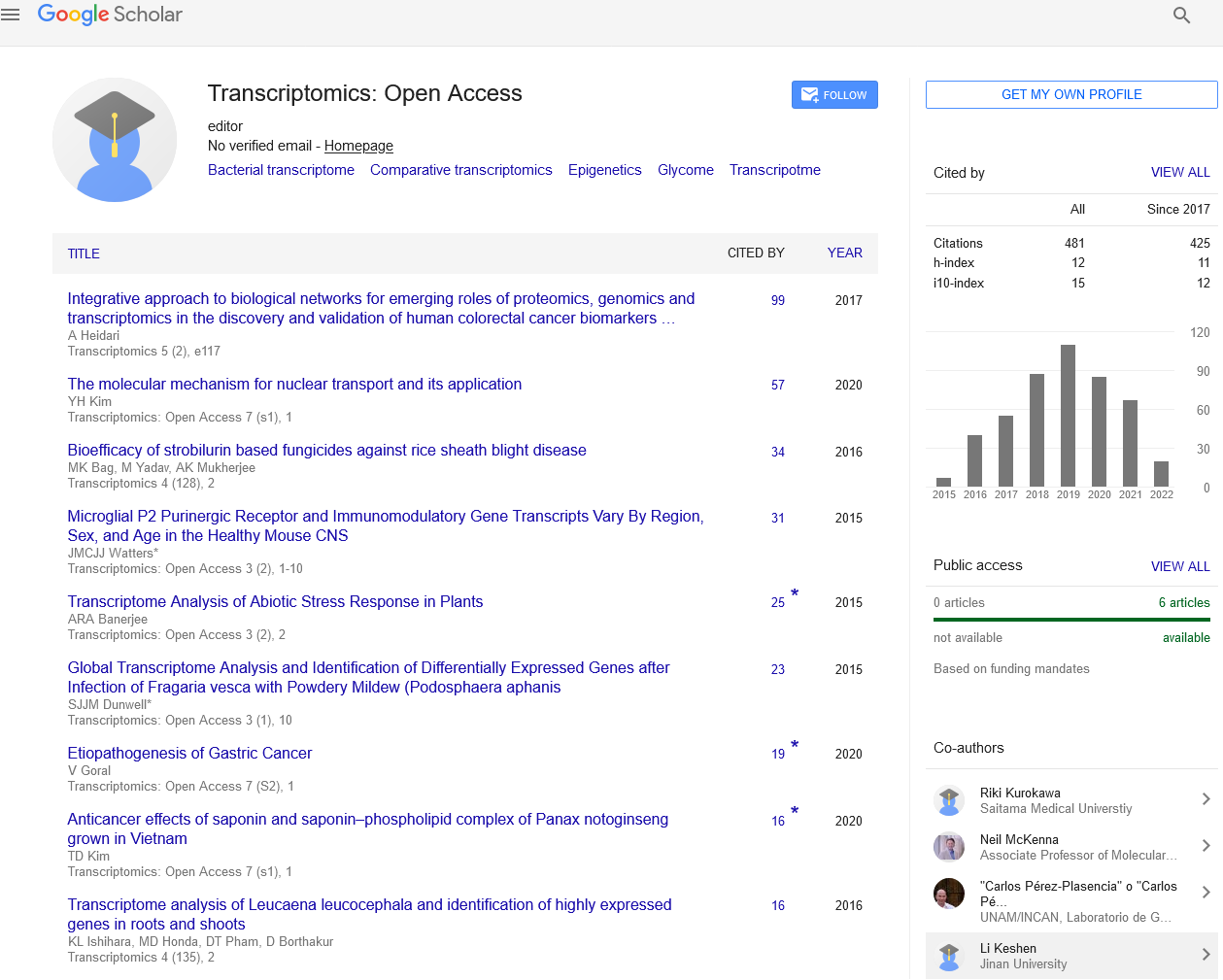Transcriptomics: Open Access : Citations & Metrics Report
Articles published in Transcriptomics: Open Access have been cited by esteemed scholars and scientists all around the world. Transcriptomics: Open Access has got h-index 13, which means every article in Transcriptomics: Open Access has got 13 average citations.
Following are the list of articles that have cited the articles published in Transcriptomics: Open Access.
| 2024 | 2023 | 2022 | 2021 | 2020 | 2019 | 2018 | 2017 | 2016 | 2015 | 2014 | 2013 | |
|---|---|---|---|---|---|---|---|---|---|---|---|---|
Total published articles |
30 | 32 | 30 | 25 | 24 | 0 | 2 | 4 | 14 | 28 | 6 | 6 |
Research, Review articles and Editorials |
0 | 2 | 1 | 10 | 5 | 0 | 1 | 1 | 9 | 17 | 5 | 6 |
Research communications, Review communications, Editorial communications, Case reports and Commentary |
14 | 40 | 30 | 16 | 8 | 0 | 1 | 2 | 5 | 11 | 1 | 0 |
Conference proceedings |
0 | 0 | 0 | 0 | 0 | 0 | 0 | 50 | 52 | 111 | 0 | 0 |
Citations received as per Google Scholar, other indexing platforms and portals |
42 | 58 | 67 | 78 | 96 | 113 | 96 | 67 | 57 | 6 | 2 | 3 |
| Journal total citations count | 552 |
| Journal impact factor | 2.08 |
| Journal 5 years impact factor | 4.98 |
| Journal cite score | 6.92 |
| Journal h-index | 13 |
| Journal h-index since 2019 | 11 |
Important citations (451)
Racemization in post-translational modifications relevance to protein aging, aggregation and neurodegeneration: tip of the iceberg |
|
Mechanisms mediating nuclear trafficking involved in viral propagation by dna viruses |
|
Adamantane, irene, naftazone and pyridine-enhanced precatalyst preparation stabilization and initiation (peppsi) nano molecules |
|
Nup98 – a novel predictor of response to anthracycline-based chemotherapy in triple negative breast cancer |
|
Investigation of prevention, protection and treatment of ritonavir effectiveness on coronavirus disease–2019 (covid–19) infection using fourier transform raman (ft–raman) biospectroscopy |
|
In situ monitoring of ritonavir protective and therapeutic influence as a potent drug on coronavirus disease–2019 (covid–19) infection by attenuated total reflectance–fourier transform infrared (atr–ftir fingerprint) biospectroscopy |
|
Nuclear export mechanisms of circular rnas: size does matter |
|
A stimulated ft–ir biospectroscopic study of ritonavir protective and therapeutic effect as a potent drug on coronavirus disease–2019 (covid–19) infection |
|
Study of stimulated raman biospectroscopy in ritonavir as a potent drug against coronavirus disease–2019 (covid–19) infection |
|
Sydnone, münchnone, montréalone, mogone, montelukast, quebecol and palau’amine- enhanced precatalyst preparation stabilization and initiation (eppsi) nano molecules |
|
Simulation of interaction of synchrotron radiation emission as a function of the beam energy and californium nanoparticles using 3d finite element method (fem) as an optothermal human cancer cells, tissues and tumors treatment |
|
Pros and cons of livermorium nanoparticles for human cancer cells, tissues and tumors treatment under synchrotron radiation using mathematica 12.0 |
|
Study of human cancer cells, tissues and tumors treatment through interaction between synchrotron radiation and cerium nanoparticles |
|
Targeting nuclear import and export in hematological malignancies |
|
Recent new results and achievements of california south university (csu) biospectroscopy core research laboratory for covid-19 or 2019-ncov treatment: diagnosis and treatment methodologies of “coronavirus” |
|
Autophagic removal of farnesylated carboxy-terminal lamin peptides |
|
A new approach to interaction between beam energy and erbium nanoparticles |
|
Perspectives on sub–nanometer level of electronic structure of the synchrotron with mendelevium nanoparticles for elimination of human cancer cells, tissues and tumors treatment using mathematica 12.0 |
|
Multiple partial recognitions in dynamic equilibrium” in the binding sites of proteins form the molecular basis of promiscuous recognition of structurally diverse ligands |
|
Effectiveness of einsteinium nanoparticles in optothermal human cancer cells, tissues and tumors treatment under synchrotron radiation |
|
